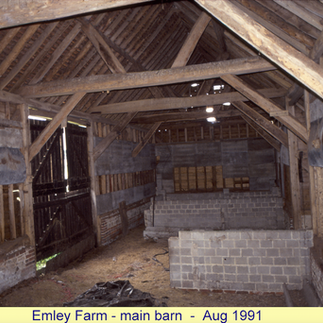Emley Farm
- David Young
- Nov 23, 2023
- 4 min read
Updated: Aug 30
This article written by Jackie Rickenberg was published in the Parish Magazine in August 2021

After reading about Shepherd’s Cottage in last month’s article, Anne Treadwell, a Bowlhead Green resident, wondered whether we could shed some light on the origins and past residents of Emley Farm, in Bowlhead Green. Some of you may be familiar with this, now National Trust owned, property as it is one of the oldest and most prominent houses within the Parish of Thursley.
The oldest portion of the Grade 2 listed Emley Farm is the rear section. It was a four-bay timber-framed smoke bay house with many characteristics of immediately post medieval period, circa 1550-1590. The remainder of the house is early seventeenth century, with the front porch being added in the later nineteenth century and then the timber framed bathroom wing added in the 1920’s. The bay window in the study is believed to have come from nearby Cosford House.

The house also boasts one of the best-preserved bread ovens and a brick lined well 140 feet deep, the deepest in Thursley. Access to the well would originally have been at floor level and is now built around. It is said that donkeys were used to raise the water and they were reportedly kept in the cellar. The house has five bedrooms and bedroom 4 is known as the Witches Room as it was the dressing room used by the children for dressing up at Halloween. Outside there are wonderful barns, a granary and extensive farm buildings, used for the traditional mix of arable and pasture farming (although at the turn of the 1800’s, it was predominately a turnip growing farm).
Emley was once part of Witley Park Estate and from the early 1800’s was lived in by the Loring family. A Loring daughter married Colonel Vesey and they lived at Emley until 1929. Emley was the Vesey’s country house as the following advertisement in the West Sussex Gazette of 31st July 1924 would indicate; “Cook and betweenmaid wanted end Aug. Cook about 30, betweenmaid about 15. Two in family; two in nursery. House-parlourmaid, nurse and nursery nurse kept. Town and country. Apply Mrs Vesey. (Two things. How employment law has changed and secondly, remarkable really that I have lived until this age without the services of a betweenmaid being essential!).

Shortly after the Vesey’s left, the farm was then occupied by Mr Bertram Austin, a retired Royal Artillery Colonel who, tragically, had two prosthetic legs after being blown up in the Great War. In those days prosthetic limb technology had, sadly, not quite reached the awe-inspiring levels it deserves today. It was reported that “Mr Austin never oiled his legs and every Sunday would squeak as he walked up the aisle for the service”. Despite his disability Bertram Austin went on to successfully race cars at Brookwood circuit. Col. Austin had bought a new Bugatti, directly from a Paris showroom and drove it back to his Surrey farmhouse. He was undoubtedly a man of some spirit as he had his new Bugatti modified to accommodate his disability, creating a hole in the scuttle and fitting larger pads on the control pedals. He left Emley in 1948 to live in Cornwall.

Circa 1920's, Captain Bertram Austin racing his Bugatti at Brooklands. The author and lecturer, who lost both of his legs on the Somme, took part in the Spring meeting of the Junior Car Club at Brooklands (Photo by Popperfoto via Getty Images/Getty Images)
Another resident was Dr Dennison, who bought the farm in 1953 for £11,000, later buying another two boggy fields, which until then had been part of Begley Farm. It was after his death in 1991 that Emley Farm was bequeathed to the National Trust and more restoration work was carried out. It is now available for rent and among the various domestic details about the farmhouse on their website, comes the warning “Long eared bats roost in the loft at this cottage. If a bat gets into the living room during your stay, please open a window to allow it to escape”! Incidentally, Emley was originally called Imbeleg in its early days. The first element is the Old English “imbe”, meaning a swarm of bees i.e., the place where the bees swarm.


An aside.
Whilst researching this article, I came across this hysterical article from the Nottingham Evening Post of 2 Nov 1919.
COAT, NOT GOAT. COMEDY OF A TELEPHONE CALL AND ITS SEQUEL.
Hello! Is that you? Please meet me the station -with the car, and bring a coat." Dench was chauffeur at Lower House, Bowlhead Green. Godalming, and, during a telephone call, was puzzled to hear his mistress (as he thought) request him to bring a goat to the station in the motorcar. As his mistress kept goats, he obeyed. But the strange cargo attracted the attention of the police, with the result that a summons was taken out against the faithful chauffeur for " moving a goat contrary to the Surrey Foot and Mouth Disease Order." The explanation was made to the court yesterday and amid general hilarity, the case was dismissed.



















